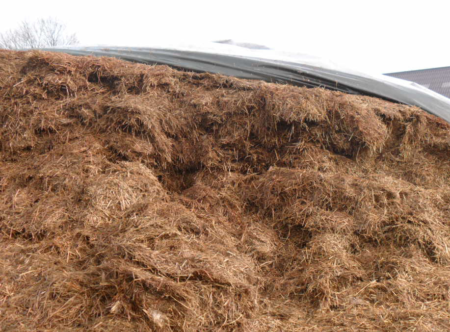Silage troubleshooting in grass silages
Grass silage with moulds

There are many potential reasons why grass silage may heat, be affected by mould or fail to ferment properly. The following pages support you in analysing vulnerabilities in silage management and help you identify potential causes and solutions.
Reheating/mould immediately underneath the film+
Possible causes
- Holes in the silage film, e.g. caused by birds or mice
- Insufficiently strong silage film
- No oxygen barrier
- No sand bags as cross lines
Solutions
- Use oxygen barrier
- Use main silage plastic that is at least 150 µ thick
- Use silage netting to protect against mechanical damages
- Use sand bags as cross line on the silage face to prevent air from entering
Reheating/mould at the upper silo face+
Possible causes
- Inadequate compaction
- Pick-up rate (chop length, deposited layers) and silo geometry (i.e. silo size) do not match
- Incorrect removal technique and overfilling of silage clamps: loosened, rough silage face
Solutions
- Improve compaction: Reduce the pick-up rate per unit of time if the silo surface is not yet large enough
- Avoid “ripping” harvesting techniques
Reheating/mould about 20 cm below the surface+
Possible causes
- Excessively deep layers deposited at the top: This prevents deep compaction (max. 30 cm, depending on tyres)
- Silage layer excessively contaminated with soil and dirt
- The top layer is often unaffected as it cools and temperatures are therefore too low for moulds or yeasts to grow
Solutions
- Max. 15 – 20 cm layer depth
- Maximise deep compaction during rolling: maximise tyre pressure; avoid using dual tyres
- Harvest clean Silage: avoid setting harvesters too low, increase cutting height
Reheating/mould in the middle of the silage+
Possible causes
- Excessively dry substrate layer: old, excessively wilted material
- Excessively deep deposited layers
- Insufficiently chopped material
Solutions
- Max. 15 – 20 cm depth of deposited layers
- Avoid introducing over-mature and/or excessively wilted material into the middle of your silage: instead ensile separately (round bales, square bales, separate silo) or deposit in thin layers at the very bottom of the silo
Reheating/mould randomly distributed+
Possible causes
- Insufficiently chopped or distributed over-mature substrate (in combination with inadequate compaction)
- Inhomogeneous silo filling, presence of cavities, slip
- Inadequate grassland management, e.g. harvest residue from the previous cut (rough-stalked meadow-grass)
Solutions
- Chop over-mature material very short (2 cm)
- Fill silos evenly: avoid “cavities” resulting from unloading large forage quantities
- Prevent slip of harvesting vehicles on Silage by pulling up the compaction tractor
- Avoid harvesting residue from the previous cut: remove rough-stalked meadow-grass with a harrow and discard
Reheating/mould around the edges+
Possible causes
- Incorrect filling of silage clamps (sloped outside edges): poor compaction along edges
- Ingress of air or water, e.g. if no side wall or oxygen barrier is used
Solutions
- Rolling right up to the silo wall
- Use side wall and oxygen barrier
Silage smells of butyric acid+
Possible causes
- High contamination (crude ash) of harvested material due to attached soil or late fertilisation with liquid manure before the harvest
- Extensive fertilisation: shortage of nitrate in plants as a natural inhibitor of clostridial growth during the ensiling process
- Ensiled material too wet: fermentability coefficient too low
Solutions
- Clean harvest, reduce soil contamination
- Adjust fertilisation
- Review silage additive used
Rotten, slimy layer on the surface+
Possible causes
- Holes in the silage film, e.g. caused by birds or mice
- Long delay in covering silage
- Pockets of air between the film and silage
Solutions
- Cover the silage as soon as rolling has been completed
- Use oxygen barrier
- Use main silage plastic that is at least 150 µ thick
- Use silage netting to protect against mechanical damage
